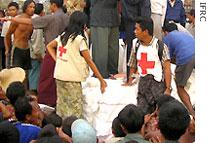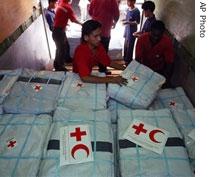VOA慢速英语 2008 0521b(在线收听)
EXPLORATIONS - International Red Cross Helps Victims of Natural Disasters
The Red Cross is leading efforts to help victims of the cyclone in Burma, earthquake in China and starvation in Ethiopia. Transcript of radio broadcast:
20 May 2008
VOICE ONE:
I’m Steve Ember.
VOICE TWO:
And I’m Barbara Klein with EXPLORATIONS in VOA Special English. International aid organizations are helping survivors of two disasters this month -- a severe storm in Burma and a major earthquake in China. Today we tell about one of these organizations, the International Federation of Red Cross and Red Crescent Societies.
(MUSIC)
VOICE ONE:
On May second, a severe storm hit the Irrawaddy Delta area of Burma. High winds, heavy rain and floodwaters killed tens of thousands of people. Hundreds of thousands of homes were damaged. The secretary-general of the Red Cross Federation, Markus Niskala, says Cyclone Nargis has affected as many as two million people. He says they lack shelter, food, clean water and health care.
VOICE TWO:
 |
| Red Cross volunteers help provide aid in Bogolay, Burma |
About twenty-seven thousand Red Cross volunteers in Burma began helping the survivors immediately after the cyclone hit. They gave supplies to people in emergency shelters. The International Federation of Red Cross and Red Crescent Societies has sent tons of supplies and equipment to Burma's Red Cross. The organization said Burma's Red Cross was working without delay to help people in need.
The International Red Cross says clean water is urgently needed to prevent diseases from spreading. The organization launched an appeal for fifty-one million dollars to help five hundred thousand victims of the storm over the next three years.
VOICE ONE:
Pressure continues on Burma's military-ruled government to accept foreign help for survivors of Cyclone Nargis. On Monday, the government said it would let aid workers from Southeast Asian nations enter the country.
Reports say the International Federation of Red Cross and Red Crescent Societies expects to double its emergency aid to the area this week. It has asked for five airplanes to fly supplies from Malaysia to Burma. Each plane has forty tons of supplies.
VOICE TWO:
On May twelfth, a major earthquake struck Sichuan Province in southwestern China. The earthquake killed tens of thousands of people. It also destroyed many buildings, including the homes of up to five million people. Health officials warn that a lack of food, clean water and medical supplies could lead to the spread of disease.
 |
| Volunteers from a Red Cross Student Association in Shanghai collect money for earthquake victims |
Immediately after the quake, the Red Cross Society of China began to organize an aid operation. Workers and volunteers have been providing temporary shelter, food and water to survivors in the affected area.
On Sunday, Chinese media reported that the Red Cross Society of China gave about one million dollars worth of emergency supplies to earthquake survivors. The supplies included food, water, clothing and temporary shelters.
VOICE ONE:
People in Ethiopia are facing another kind of disaster -- starvation. The International Federation of Red Cross and Red Crescent Societies says it is taking action to help an estimated forty thousand Ethiopians.
The Red Cross is launching an emergency appeal for almost two million dollars to provide urgently needed food. Severe lack of rain has caused food shortages in Ethiopia and other countries in Africa.
The director of programs for the Red Cross, Thomas Gurtner, says the goal of the appeal is to help the affected Ethiopians until local crops are harvested in October.
(MUSIC)
VOICE TWO:
 |
| Workers load supplies for Burma at a center near Kuala Lumpur |
People around the world welcome the flags and signs of the Red Cross movement during natural disasters and war. The Red Cross flag shows two red lines crossing on a white surface. The Red Crescent serves mainly Muslim countries. Its flag is white with a red, crescent moon. Red Cross and Red Crescent organizations help survivors of many kinds of natural disasters. When thousands of people flee their homes, Red Cross and Red Crescent teams go to work.
The teams study the situation and conditions in affected areas. They observe whether the people are moving from country to country or moving within their homeland. Are the people fleeing from oppression and war? Are they moving because of natural disasters or economic reasons? The answers help decide how the aid effort will be organized.
VOICE ONE:
The International Committee of the Red Cross is the lead agency within the Red Cross and Red Crescent Movement. A coalition makes possible the work of the Red Cross Movement. It has one hundred eighty-six national aid societies. The societies belong to the International Federation of Red Cross and Red Crescent Societies.
The American Red Cross is one such national organization. Money given by Americans mainly supports this private group. Volunteers perform most of the group's work.
VOICE TWO:
The American Red Cross carries out many activities in the United States. It provides more than half the nation’s blood supply. The American Red Cross trains millions of people in life-saving skills. It provides health care for more than two million people.
The Red Cross has taught millions of people to swim. Red Cross community programs provide food for poor people. Volunteers take meals to people who are unable to prepare their own food. Other volunteers visit patients in hospitals and treatment centers for sick or disabled persons.
VOICE ONE:
The American Red Cross also helps people in the armed services. It helps them communicate with their families. Thousands of families each year receive emergency information about service members in faraway places.
The American Red Cross sends help to thousands of disaster areas in the United States each year.
For example, on May tenth, severe windstorms struck parts of the central United States. The American Red Cross sent several teams of volunteers to the hardest hit areas. Volunteers opened shelters for people whose homes were destroyed. They provided food, clothing and medical care.
VOICE TWO:
The many national Red Cross groups cooperate through the International Federation of Red Cross and Red Crescent Societies. The headquarters of the International Federation is in Geneva, Switzerland.
The headquarters of the International Committee of the Red Cross is also in Geneva. This group acts as a neutral negotiator among warring nations to protect human rights. It attempts to make sure that the Geneva Conventions are obeyed. These rules guarantee humane treatment of soldiers and civilians. For example, prisoners of war may not be tortured to get military information from them. And, poison gas is banned as a weapon.
The International Red Cross Conference meets every four years to discuss the Geneva Conventions. The Red Cross and Red Crescent movement believes nations must take more responsibility for reducing violence and unfair treatment. The movement urges improved conditions for people suffering from war and disaster.
(MUSIC)
VOICE ONE:
The proposal that led to the Red Cross movement was made almost one hundred fifty years ago. A Swiss man, Jean Henri Dunant, proposed that every country establish permanent aid organizations. Mister Dunant said these groups should be politically neutral. He wanted the organizations to help sick and wounded soldiers.
Mister Dunant had seen the terrible suffering of soldiers injured in war. He established a field hospital in the battle area for the wounded soldiers of both sides after a conflict in Italy. That was in eighteen fifty-nine, during the Austro-Sardinian War.
VOICE TWO:
Mister Dunant wrote about his experiences in a book, “A Memory of Solferino.” It helped many people understand the need for an international aid agency. The influence of Jean Henri Dunant helped create the International Committee of the Red Cross. It was established at a meeting in Geneva in eighteen sixty-three.
Today, the organization that developed from his proposal continues to help survivors of natural disasters and wars around the world. The Red Cross estimates that it helps about thirty million people each year. This year is proving to be an extremely busy one for Red Cross volunteers.
(MUSIC)
VOICE ONE:
This program was written by Jerilyn Watson and Shelley Gollust. Mario Ritter was our producer. I’m Steve Ember.
VOICE TWO:
And I’m Barbara Klein. You can get transcripts, MP3s and podcasts of our programs at our Web site, voaspecialenglish.com. Join us again next week for EXPLORATIONS in VOA Special English.